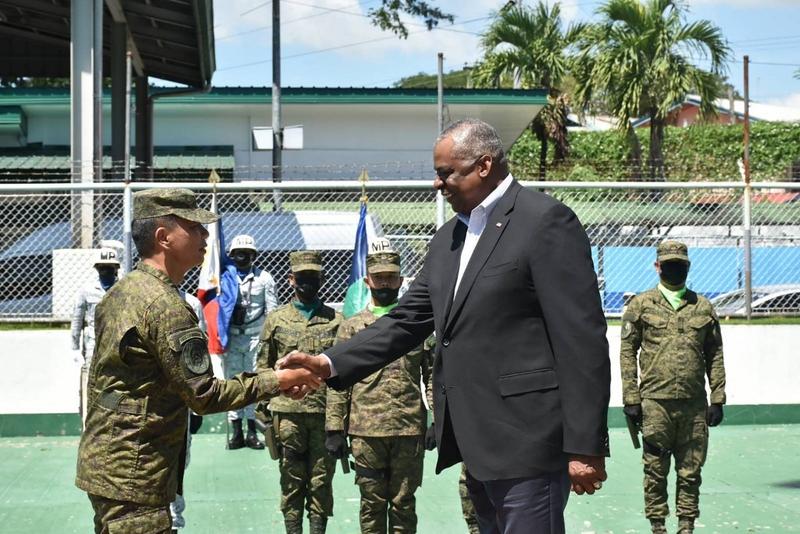 This handout photo taken on February 1, 2023 and released by Western Mindanao Command shows US Secretary of Defense Lloyd Austin (right) shaking hands with Westmincom commander Lieutenant General Roy Galido (left) shortly after arriving at the Westmincom headquarters in Zamboanga City, in southern island of Mindanao. (PHOTO / WESTERN MINDANAO COMMAND / AFP)
This handout photo taken on February 1, 2023 and released by Western Mindanao Command shows US Secretary of Defense Lloyd Austin (right) shaking hands with Westmincom commander Lieutenant General Roy Galido (left) shortly after arriving at the Westmincom headquarters in Zamboanga City, in southern island of Mindanao. (PHOTO / WESTERN MINDANAO COMMAND / AFP)
After visiting the Republic of Korea, United States Defense Secretary Lloyd Austin arrived in Manila on Tuesday night. It's Washington's latest move to target China by further bolstering the US' defense partnership with the Philippines, its Southeast Asian ally.
Even before Austin's arrival, some US media have been hyping up the expectation that the two allies will reach an agreement on expanding the US military's access to key bases in the Philippines. The deal will reportedly allow the US to establish up to five new US military sites at Philippine bases, one of which is located on Luzon Island and another on Palawan Island. Localities that are close to China's Taiwan and Nansha Islands respectively.
Obviously, the current US administration under Joe Biden is attaching greater importance to its military alliance with the Philippines, deeming it as an irreplaceable chess piece in the US regional playbook, which is now all about targeting and containing China.
Previously, as former Philippine president Rodrigo Duterte implemented a friendly policy toward China and could not see eye to eye with Washington on some regional and domestic issues, the US strategy of stoking tension between Manila and Beijing over the South China Sea disputes, which was initiated by the Obama administration, failed to live up to Washington's wishes.
Since Philippine President Ferdinand Romualdez Marcos Jr. took office, the Biden administration has seen a chance of using the Philippines as a stepping stone to make waves over regional issues again. At present, the US military already has five bases in the Philippines on a rotating basis, and doubling that number will take US-Philippines defense cooperation to a higher level, which will have profound implications for regional peace and stability.
In the worse-case scenario of war, the possibility of which some on the US side have recently been hyping up — claiming that the US will fight China in two years — Washington believes that deepening the US-Philippine military alliance will boost the strategic advantage of the US in the region and increase its chances of winning a war.
The US has increasingly become a destabilizing factor and a troublemaker in the Asia Pacific and it is willing to sacrifice regional peace and stability for its own selfish strategic gains, as Austin's trip shows.
Sino-Philippine ties have remained stable and robust in the past few years, producing benefits for both sides and contributing to the building of peace and stability in the South China Sea. Such a desirable momentum has also contributed to regional efforts to negotiate a code of conduct for the waters.
Given this, it would be unwise to allow foreign forces to disrupt the current rosy picture, let alone let them to meddle in regional issues and drive a wedge between countries in the region.


